|

Luscombe aircraft history, performance and specifications
|
 |

Thanks to Brian R.
Baker
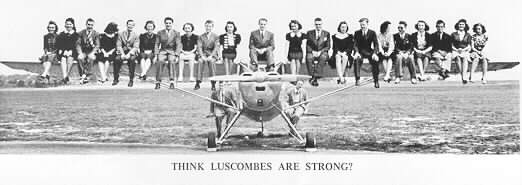
1933: (Donald A)
Luscombe Airplane
Co, Kansas City MO.
First plant was the
old Butler Blackhawk
facility. 1935: New
plant at Mercer
County Airport, West
Trenton NJ. Firm
also did aircraft
maintenance and
operated the
Luscombe School of
Aeronautics, with
students providing
some of the
production labour
force. 1939: Don
Luscombe edged out
of company after
public stock sales
resulted in
financial control
being taken over by
Leopold Klotz, who
in turn was removed
from management
during WW2 because
of his Austrian
citizenship and the
firm vested by the
Alien Property
Custodian Division
of the Treasury Dept
to manufacture
components for
Grumman Corp. 1944:
After receiving U S
citizenship, Klotz
resumed control of
the firm to again
became active in its
management. Aug
1945; Luscombe
Aircraft Corp,
Garland TX.
Production resumed
with Models 8A, 8D,
8E, 8F, T8F, and
11A. Feb 1950:
Bankruptcy,
acquisition by TEMCO,
Dallas TX. 1954:
Acquired by Silvaire
Aircraft & Uranium
Corp (pres: Otis
Massey), Ft Collins
CO. 1964: ATC and
tooling purchased by
Moody Larsen,
Bellville MI. 1985:
Purchase of the ATC
for 11-A was
negotiated by an
unrelated Luscombe
Aircraft Corp,
Carson City NV, but
the deal fell
through. c.1994:
ATCs acquired by Don
Luscombe Aviation
History Foundation (DLHAF),
Chandler AZ (pres: P
Douglas Combs); the
Foundation was
providing parts,
service, and rebuilt
aircraft, and new
production of the 8F
by Renaissance
Aircraft LLC had
been started, with
components to be
produced by Zenair
Ltd of Canada, the
Czech Aircraft Works
of the Czech
Republic, and the
DLHAF.
For some reason
Luscombes suffered
from their contact
with the FAA's Civil
Register. This was
because people
within the agency
weren't familiar
with the airplanes,
and because
mechanics and owners
responsible for the
paperwork didn't
know what to call
them, and FAA took
the information
given to it. The
result was a series
of designations,
including serious
errors, that only
leads to confusion.
This was carried
over to other
publications and
caused
identification
problems for serious
historians. Modified
aircraft were
sometimes listed as
new types, and a few
owners added their
names to the
manufacturer's,
adding to the
confusion. Also,
many aircraft listed
as Model 8 were
actually later
models.
A basic
identification
problem becomes
evident when dealing
with modifications —
a model 8A
with a Continental
C-85 replacing the
A-65 is a model 8A
(modified), not an
8E. It might look
like an 8E and have
the fuel tank, rear
window
modifications, and
wing landing lights,
but it simply is not
an 8E. Therefore,
obtaining an
identification from
the Civil Register
does not
automatically assure
an accurate type
identification.

Luscombe-4, aka 90
1938; 90hp Warner;
span: 32'0" length:
20'11" load: 625# v:
130/115/45 range:
580; ff: 3/10/37 (p:
Ignatius Sargent).
Scaled-down Phantom,
originally name
Sprite, then 90,
finally 4; Lyle
Farver (fuselage),
Bill Shepard
(wings). $3,975;
POP: 6 [X1017
(Sprite), NX1253,
NC1325, NC1337,
NC1344, NC22026].
The only survivor is
currently under
restoration in
California [N1337].

Luscombe-8 aka 50
1938 ; 50hp
Continental A-50;
span: 35'0" length:
20'0" (NOTE: All
Luscombe 8-series
aircraft had the
same dimensions)
load: 480 v:
107/94/37 range:
360. Frank Johnson,
Howard Jong (aka
Young), Fred Knack.
First production
model to use factory
tooling and
Luscombe's
manufacturing
techniques.
All-metal with
fabric wing
covering, pressure
cooled cowling, and
ingenious design
features for ease in
maintenance and
reparability,
including breakaway
landing gear struts
to preserve centre
section and sheet
metal tip spars to
protect the main
extruded spars.
Early models had
tailskids and no
brakes. Performance
was adequate, but
65hp model later won
the popularity.
$1895; POP: 113;
prototype [NX1304]
built in 1937 as 50,
but registered as 8.
All 8-series were
produced under
(694).
 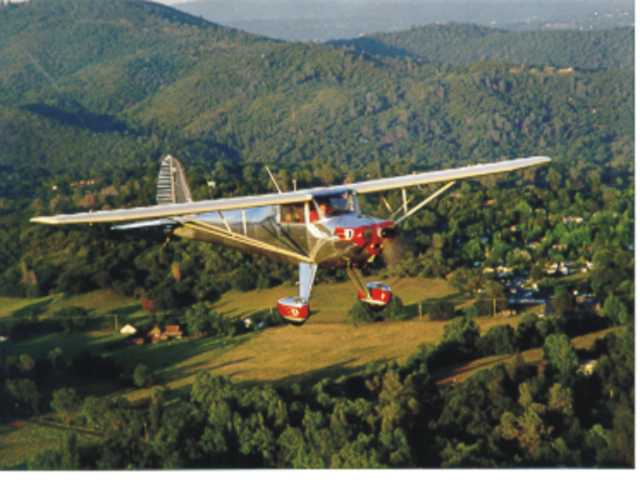
Luscombe-8A 1939;
65hp Continental
A-65-8F; load: 510#.
Produced under
(A-694) until 1948
with numerous
changes, but all had
A-65 engines; most
had rear fuselage
fuel tanks and few
frills. First
production identical
to 8 except for the
A-65 engine.
The outbreak of WW2
curtailed production
at 557 units, but
manufacture resumed
with the post-war 8A
as the major
production model.
Many changes were
made to reduce
production costs,
notably introduction
of a stamped-rib,
fabric-covered wing
in 1946
(Eugene W Norris,
wing redesign), and
a simplified
all-metal wing later
the same year, with
stiffeners replacing
the conventional rib
structure and a
single strut instead
of the V-strut
arrangement on
fabric-winged
aircraft. The
squared-tail units
first appeared early
in 1947, along with
a stronger
cantilever Siflex
landing gear.
Whatever the wing,
tail unit
configuration, gear
type, or fuel tank
arrangement was, all
A-65-powered
aircraft were 8As
with 1260# gross
weight.

Toward the
end of the
production run, as
the company
experienced
financial
difficulties, many
variations existed.
POP: 3,695 included
3,138 built
post-war; included 1 (c/n
1653) acquired by
the Army in Panama
after the outbreak
of WW2 and
designated UC-90A
[42-79549]. Many 8As
were modified by the
installation of more
powerful engines,
additional wing
tanks, and more
advanced
instrumentation. In
fact, few exist in
original
configuration — most
were modified in
some way over the
years.
Some rebuilds
even had different
types of wings;
original fabric
wings became metal
wings, while a few
were even backdated
from metal to fabric
wings. Since the
only new tail units
being manufactured
are the squared
variety, many older
types have the later
tail units, and
sometimes a
combination of
types. A few have
been highly modified
for aerobatic work,
with shortened wing
spans, etc. One with
a 90hp Ken-Royce
radial was called "Doncoupe"
because of its
resemblance to a
Monocoupe. A few
early homebuilts, as
well, used Luscombe
wings and other
components.
8A Silvaire Master
1941 (694) = 65hp
Continental A-65-8.
The "Master" was
developed to provide
an illusion that
Luscombe was
producing
military-contract
training aircraft
and so should
continue receiving
shipments of
aircraft aluminium.
The strategy worked,
and Luscombe
continued to receive
aluminium until the
outbreak of the war.
POP: 1 prototype
[NC37038].
Production models
were to have the
A-75 motor, and this
type was actually
produced as 8D.
Luscombe-8B, 8B-2
1940; 65hp Lycoming
0-145. Essentially a
Lycoming-powered 8A,
it did not sell
well.
$1,785-1,885 in
1941; POP: 85,
included 1 (c/n
1809) acquired by
Army in Panama at
the beginning of WW2
as UC-90 [42-79550].
Although listed in
some publications,
no Luscombe records
of a model 8B-2
exist. Some 8Bs were
converted to other
models by engine
changes.

Luscombe-8C 1940;
75hp Continental
A-75-8J with fuel
injection; load:
480# v: 118/107/40
range: 340. This
upgraded 8A entered
production in June
1940, and
immediately became a
best-seller, was
first of the breed
to be referred to as
Silvaire. $2,795;
POP: 278. Many were
used by Civilian
Pilot Training
Program (CPTP)
contractors for
military student
flight training.
Gross wt: 1200.
Standard 14-gal rear
fuselage tank, with
provision for
wing-mounted
auxiliary tanks.

Luscombe-8D 1941;
75hp Continental
A-75-8J; load: 530#.
Developed for CPTP,
essentially a
production model 8A
Master with 23.5-gal
fuel capacity in two
wing tanks, revised
instrument panel.
Gross wt: 1310#.
POP: 97, included 11
in 1945 from the new
Dallas plant.

Luscombe-8E 1946;
85hp Continental
C-85-12F; load: 550#
v: 122/114/43 range:
400. The original
prototype was a
fabric-wing aircraft
with a C-85 engine
with no starter or
generator [NC71468].
[NC71645] became the
first metal-wing 8E
prototype. Designed
to compete with
Cessna 140,
production units had
12.5- or 15-gal wing
tanks, and most had
full electrical
systems. Additional
modifications
included rear
windows and an open
compartment,
commonly known as a
"hat throw," located
where the fuselage
fuel tank had been.
$2,995; POP: 834.
Many 8Es were still
flying in 1999, some
highly modified.
XT8E 1947 = 85hp
C-85-12. POP: 3
prototypes for 1947
Army liaison
competition; first
was [NX2788K]. Army
requirements stated
that the aircraft
had to either be in
current production
or hold a current
type certificate —
XT8E did not qualify
on either count
with only 10% non-8E
components. Changes
included a new
forward fuselage
with tandem seating
arrangement, large
windows, a
bubble-type rear
window, and a door
on the right side
only. Although the
plane completed the
test program
successfully, the
contract was awarded
to Aeronca's L-16A
on the basis of its
lower selling price.
The type was
subsequently
developed into the
T8F Observer.

Luscombe-8F 1948;
90hp Continental
C-90-12F; load: 540#
v: 128/120/45 range:
490. Upgraded 8E
with motor, full
electrical, and
cantilever Siflex
landing gear. Fuel
capacity was 25
gallons, in two
12.5-gal wing tanks,
although some
aircraft were
delivered with two
15-gal wing tanks.
This was the
ultimate Model 8
Silvaire produced,
produced in several
versions differing
mainly in cosmetic
items, such as paint
trim. When Luscombe
went bankrupt in
1948, its assets
were acquired by
TEMCO, who produced
a number of 8Fs in
1950-51. Production
ceased in 1951 due
to TEMCO's military
contract
commitments. POP:
379 from 1948-51.

T8F Observer 1948;
90hp C-90-12F; load:
530#. Developed from
XT8E, T8F was
marketed as a
pipeline patrol
aircraft. The
airframe was
virtually identical
to the
XT8 and used 90% of
8F components. Two
versions were
produced, a "Deluxe"
model with full
electrical, and a
"Special" with no
electrical. POP: 73.
Contrary to some
paint schemes seen
at fly-ins, no T8F
was ever operated by
any military
organization, and
military-marked
Observers are
historically
inaccurate.
T8F Crop Master
1949; 90hp C-90-12F;
load: 528#.
Production T8F with
flaps and built-in
spray equipment.
Spray unit
manufactured by
Independent
Cropdusters included
two 30-gal,
self-agitating
chemical tanks
inside the wings,
two wind-driven
rotary spray
dispensers just
below the
single-spar wing
struts, and oversize
tires. POP: 35, of
which most were
later converted to
standard T8F
configuration.
T8F-L 1950; 90hp
C-90 "injector-type"
engine; load: 500#.
POP: 2 prototypes
modified from T8Fs
(one was a sprayer)
for 1949 Army
liaison plane
competition.
Extensively modified
with swing-out
engine mounts,
larger doors,
rebuilt center
sections, unfaired
Siflex landing gear,
toe-actuated
hydraulic brakes,
flaps, and dual
controls (except for
brakes). [N1829B]
was flight tested at
Wright Field in
April 1949, and was
one of three final
contestants flown to
Fort Bragg NC, where
it lost out to
Cessna L-19A.
The second prototype
was a static test
airframe not used in
the competition.
Both aircraft were
subsequently
modified back to
standard
configuration and
sold.
T8G-L - Ag sprayer
planned for
installation of
Boeing 502-2
turboprop was never
built.

Luscombe-8 Turbine
1999; 150hp Apex
Turbine. This
conversion project
was first considered
by Luscombe
engineers at TEMCO
in 1950, but it was
not until 1999 that
a flying 8E
prototype was
constructed by the
DLAHF in Chandler AZ
[N2638K]. The
prototype appeared
at local fly-ins,
and performance was
reported to be
similar to that of
the 150hp
conversion.
Luscombe-9 1945
Although this model
was a project, it is
included for
continuity. In June
1945,Luscombe
considered updating
the 8 and
re-designating the
post-war production
aircraft as Model 9.
A proposal in July
was submitted to CAA,
whose view was that
a change in the
model number would
require complete
recertification, but
that upgrades would
be approved without
recertification as
long as the model
number remained the
same. The project
was dropped, and
Model 9 enjoyed only
a three-week
lifespan.
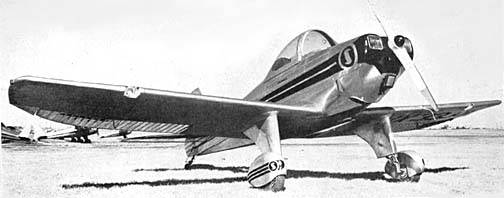

Luscombe-10 1945;
65hp Continental
A-65-8F; span: 25'
length: 17'9"
Model 10,
an attempt to build
the fastest aircraft
of its class, was essentially built up
from parts -- there
was no engineering
or structural
analysis done.
Designed by
Mischa Kantor, the fuselage centre
section was
hand-built, while
the tail unit,
engine, and
cantilever wing were
modified from 8A
components. The
first test flight by
Bob Burns almost
ended in disaster
when the main
landing gear
threatened to fail.
After some redesign,
Burns successfully
flew the airplane
once in Jan 1946,
commenting that it
was a very good
airplane and needed
no changes.
Subsequent analysis
indicated that there
would be no market
for the type, and
development was
dropped. John Swick,
in The Luscombe
Story, claims
the prototype was
later destroyed in a
windstorm, while
DLHAF reports that
the aircraft and all
data were destroyed
for tax purposes.

Luscombe-11A
Silvaire Sedan, 11C
1946; 165hp
Continental E-165;
span: 38'0: length:
23'6" load: 1000#
range: 500; ff (as
prototype X11):
11/8/46. Prototype
later modified,
flaps added as 11A;
lost when aft-loaded
c/g produced a flat
spin, and test
pilots bailed out.
Certificated by
restricting upward
travel of elevator,
which also made
three-point landings
impossible. Design
intent was to
compete with Cessna
170, and appeal to
"flying farmers,"
but never competed
successfully.
Production ended
with bankruptcy of
the firm in 1948. A
development of the
aircraft as 11C
featured a revised
fuselage, but this
remained only a
project. In later
years, some had
larger engines
installed. $6995;
POP 91.
11E Spartan 1999 ;
185hp
Teledyne-Continental
IO-360-ES; span:
38'6" length: 23'9"
load: 930# v:
x/130/x range: 530.
Essentially a
refinement of 11A
with tricycle gear,
modified fuselage,
and other changes
intended to
modernize the basic
design. $138,000;
POP: 1 prototype
[N747BM],
demonstrated around
the country, and
production is
expected to begin at
the firm's Altus
plant. A
higher-powered
variant with a 210hp
IO-360-25 is
presently projected.
50 1937 = Prototype
8 design began as
40hp lightplane
project by Luscombe
School of
Aeronautics
students. POP: 1
[NX1304]; ff:
12/17/37 (p: Tom
Foley). Numerous
detail differences
with later 8 series
— originally had
early type cowling,
wheel control,
rounded wingtips,
tailskid, no brakes.
Continental A-50
loaned by the
manufacturer.

C-90 (UC-90) SEE 8A,
8B.

Gullwing aka
Weatherly-Campbell
Colt, Wiggins Colt
460 1941; 190hp
Lycoming; span:
36'3" length: 23'10"
load: 1200# v:
160/140/52. Designed
and built by Don
Luscombe and Fred
Knack after Luscombe
left his company and
completed just prior
to WW2 — said to be
Don Luscombe's final
design. In 1946
Luscombe sold the
prototype [NX54082]
with all
engineering data to
Weatherly-Campbell
of Dallas, who
completed and flew
the aircraft,
renaming it Colt.
Entered in 1948 Army
competition for a
liaison aircraft, it
lost out to Ryan
Navion. In 1958 the
plane was sold to W
K Foss (Schenectady
NY), who intended to
manufacture the
type, engaging
Spibec Corp
(Philadelphia PA)
for its production,
but nothing was
done. In 1964 Spibec
sold the design to
Swallow Aircraft
Corp of Covina CA,
who planned to build
it as Swallow
460. In the late
1970s the plane was
sold to an
individual who
re-licensed it an
experimental
home-built, and as
such it attended a
number of fly-ins
before finally
ground-looping.
Recently the remains
were bought by
Luscombe historian
Jim Zazos for
restoration. It is
currently listed in
the Civil Register
as the Wiggins Colt
460.
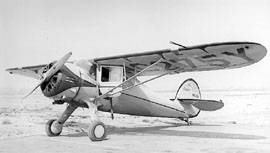

Phantom 1934 ; 145hp
Warner Super Scarab;
span: 31'0" length:
21'6" (prototype
10'10") load: 630#
(>650#) v:
168/142/45 range 560
ceiling: 19,000';
ff: 5/?/34 (p: Don
Joseph or Bart
Stevenson). Ivan
Driggs, Don Luscombe.
All-metal,
high-performance
lightplane based
loosely on Monocoupe
D-145 concepts
developed by Don
Luscombe. First
Luscombe aircraft
produced. $6,000;
POP: 25. Prototype
[NC272Y] originally
had 125hp Warner,
[NC275Y/278Y,
NC1007/1010,
NC1025, NC1028,
NC1043, NC1048,
NC1234/1235, NC1249,
NC1265, NC1278,
NC1286, NC1323,
NC25234, NC28779,
NC30449, HBEXE].
(2-528) superseded
by (552). Extremely
poor ground handling
characteristics led
to most
ground-looping and
being rebuilt.
Several Phantoms
currently exist, and
the original
prototype has been
operated by the
DLHAF for a number
of years after
extensive
restoration.
Silvaire-Luscombe 8F
aka TEMCO Luscombe
8F 1956; 90hp
Continental
C-90-12F. Source of
many Luscombe
identification
problems in the
Civil Register, the
"Silvaire" Luscombe
resulted from the
acquisition of
Luscombe-TEMCO
assets by the
Silvaire Uranium &
Aircraft Co,
organized to
continue production
of the type. First
prototype [N9900C]
flew on 9/6/56, and
production
continued until
1960, when the firm
ended production
with its 80th
aircraft. All Fort
Collins aircraft
featured the
"square" tail units
developed for late
production Luscombes
and many, but not
all, were equipped
with flaps actuated
by a handle near the
roof of the cabin.
Wheel pants were
standard, but some
operators removed
them when it made
inspection of the
wheels and brakes
difficult. At least
one 8F was modified
at the factory
with installation of
a 150hp Lycoming for
showing to dealers
during 1959-60. In
1999, DLHAF licensed
production of the 8F
to the firm of
Renaissance LLC, and
Moody Larsen,
previous owner of
Luscombe type and
production
certificates, is at
age 90 presently
involved in the
construction of the
first actual
prototype at his
facility near
Belleville MI. A
"prototype" of this
aircraft appeared at
various fly-ins
during 1999, but was
actually one of the
early Fort Collins
production
airplanes.
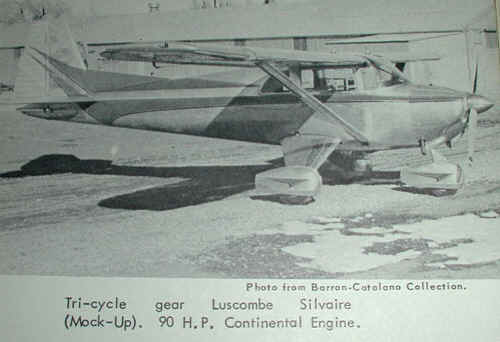
Silvaire-Luscombe 8G
1959 = 2pChwM.
Non-flying,
tricycle-gear
prototype
constructed at Fort
Collins. A flying
prototype was
nearing completion
when the company
ceased production in
1960. However, DLAHF
sources claim that
four uncertified
examples were
constructed.
|
